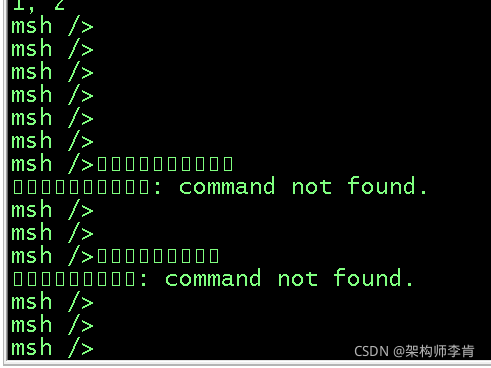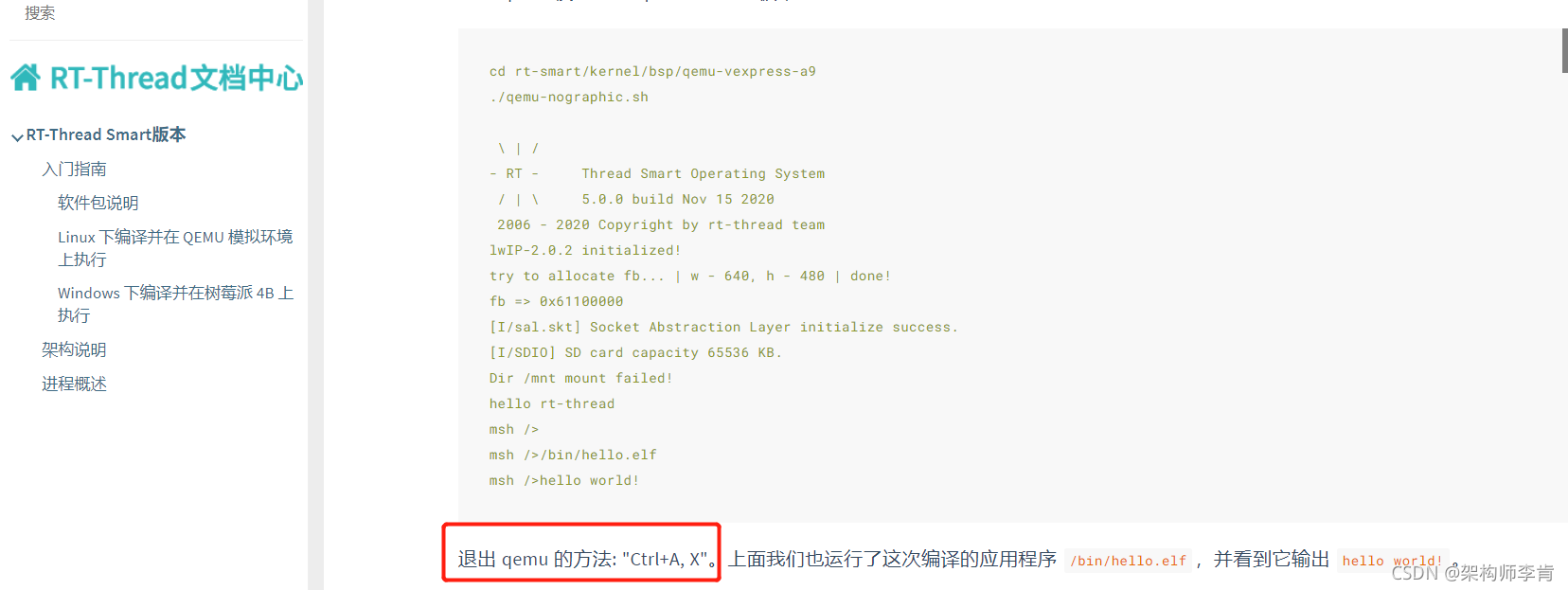本文由RT-Thread论坛用户@recan原创发布:https://club.rt-thread.org/as...
1 问题场景
相信很多人也跟我一样,刚接触RT-Thread不久,正在学习RT-Thread的路上,然而学习一款嵌入式实时操作系统,没有一个硬件开发板,在我之前的认知里面,这应该很难把RTOS的内核代码调试起来吧?
直到了解了RT-Thread,我才知道原来有QEMU模拟器这么个东西。
所以我很快就参考相关教程,把QEMU给装起来了,结合RT-Thread编译bsp的方法,很快我选择的qemu-vexpress-a9固件很快就编译出来了。
看了bsp目录下有好几个启动脚本:
bsp/qemu-vexpress-a9$ ls -al *.sh
-rwxr-xr-x 1 recan system 168 Sep 6 10:43 qemu-dbg.sh
-rwxr-xr-x 1 recan system 187 Oct 22 17:41 qemu-nographic.sh
-rwxr-xr-x 1 recan system 166 Sep 6 10:43 qemu.sh我逐个尝试,发现在我的环境下,只有./qemu-nographic.sh能够跑起来。
bsp/qemu-vexpress-a9$ ./qemu-nographic.sh
qemu-system-arm: -no-quit is only valid for GTK and SDL, ignoring option
WARNING: Image format was not specified for 'sd.bin' and probing guessed raw.
Automatically detecting the format is dangerous for raw images, write operations on block 0 will be restricted.
Specify the 'raw' format explicitly to remove the restrictions.
ALSA lib confmisc.c:767:(parse_card) cannot find card '0'
ALSA lib conf.c:4732:(_snd_config_evaluate) function snd_func_card_driver returned error: No such file or directory
ALSA lib confmisc.c:392:(snd_func_concat) error evaluating strings
ALSA lib conf.c:4732:(_snd_config_evaluate) function snd_func_concat returned error: No such file or directory
ALSA lib confmisc.c:1246:(snd_func_refer) error evaluating name
ALSA lib conf.c:4732:(_snd_config_evaluate) function snd_func_refer returned error: No such file or directory
ALSA lib conf.c:5220:(snd_config_expand) Evaluate error: No such file or directory
ALSA lib pcm.c:2642:(snd_pcm_open_noupdate) Unknown PCM default
alsa: Could not initialize DAC
alsa: Failed to open `default':
alsa: Reason: No such file or directory
ALSA lib confmisc.c:767:(parse_card) cannot find card '0'
ALSA lib conf.c:4732:(_snd_config_evaluate) function snd_func_card_driver returned error: No such file or directory
ALSA lib confmisc.c:392:(snd_func_concat) error evaluating strings
ALSA lib conf.c:4732:(_snd_config_evaluate) function snd_func_concat returned error: No such file or directory
ALSA lib confmisc.c:1246:(snd_func_refer) error evaluating name
ALSA lib conf.c:4732:(_snd_config_evaluate) function snd_func_refer returned error: No such file or directory
ALSA lib conf.c:5220:(snd_config_expand) Evaluate error: No such file or directory
ALSA lib pcm.c:2642:(snd_pcm_open_noupdate) Unknown PCM default
alsa: Could not initialize DAC
alsa: Failed to open `default':
alsa: Reason: No such file or directory
audio: Failed to create voice `lm4549.out'
\ | /
- RT - Thread Operating System
/ | \ 4.0.4 build Nov 5 2021
2006 - 2021 Copyright by rt-thread team
lwIP-2.1.2 initialized!
[I/sal.skt] Socket Abstraction Layer initialize success.
[I/SDIO] SD card capacity 65536 KB.
[I/SDIO] switching card to high speed failed!
hello rt-thread 99, 99
1, 2
1, 2
1, 2
msh />不过问题来了,我想重新编译源码,再次运行新的代码,怎么办呢?如何才能退出这个QEMU命令行控制台?
2 尝试解决
2.1 牛刀小试
大家都知道,Linux退出一个控制台启动的程序,使用CTRL+C就可以把它退出来,我试了一下,发现它压根就不认CTRL+C,只是一直输出一些乱码符号。
2.2 我放大招
既然CTRL+C不能,那我用killall -9 xxx总可以吧?难不成你还能逃脱Linux内核对你的管控?
于是另开一个控制台,直接killall -9 qemu-system-arm ,结果一试,的确可以退出QEMU(连进程都退出来了)。
但是问题来了,退出QEMU之后,这个控制台感觉乱来了,我一瞧回车,它都不好好换行了,你看看!
这就很让人难受了,控制台没法用了,而且这个时候敲命令进去还不能回显,也不知道你敲对了没有,只好退出命令行,重新登入,控制台得以恢复。
2.3 黔驴技穷
上面的这种情况,显示是我不能接受的,这个我倒是想了一下,QEMU不可能不支持退出吧,会不会什么启动参数我搞错了,于是qemu-system-arm -h,找了几个看似跟这个问题相关的参数:
qemu-system-arm -h
...
-no-quit disable SDL window close capability
...
-no-reboot exit instead of rebooting
...
-no-shutdown stop before shutdown于是在qemu-nographic.sh添加来尝试:
if [ ! -f "sd.bin" ]; then
dd if=/dev/zero of=sd.bin bs=1024 count=65536
fi
qemu-system-arm -M vexpress-a9 -smp cpus=2 -kernel rtthread.bin -nographic -sd sd.bin -no-shutdown -no-quit -no-reboot运行之后,同样在另一个控制台使用killall -9 qemu-system-arm退出,发现有的时候退出QEMU的控制台可以好好的,有的时候换行问题依然存在,没有找到规律,实在没办法,就不了了之了。
3 终极方案
3.1 发现新大陆
直到今天,我偶然翻到RT-Thread的官方文档,对RT-Thread Smart版本的介绍的时候,有一个章节是介绍使用QEMU模拟环境进行代码调试运行的,里面居然提到了如何退出QEMU!
Word天呐,那种感觉简直像是发现新大陆一样。
马上登入QEMU开发环境做测试,果然,操作竟是如此的丝滑,爽就一个字!
真的像是历史难题被解决的那种感觉。
3.2 扒一扒到底谁让QEMU退出了
第一感觉是不是RT-Thread的Finsh组件处理了这个CTRL+A,X?
于是找了Finsh的关键代码:
void finsh_thread_entry(void *parameter)
{
int ch;
/* normal is echo mode */
#ifndef FINSH_ECHO_DISABLE_DEFAULT
shell->echo_mode = 1;
#else
shell->echo_mode = 0;
#endif
#if !defined(RT_USING_POSIX) && defined(RT_USING_DEVICE)
/* set console device as shell device */
if (shell->device == RT_NULL)
{
rt_device_t console = rt_console_get_device();
if (console)
{
finsh_set_device(console->parent.name);
}
}
#endif
#ifdef FINSH_USING_AUTH
/* set the default password when the password isn't setting */
if (rt_strlen(finsh_get_password()) == 0)
{
if (finsh_set_password(FINSH_DEFAULT_PASSWORD) != RT_EOK)
{
rt_kprintf("Finsh password set failed.\n");
}
}
/* waiting authenticate success */
finsh_wait_auth();
#endif
rt_kprintf(FINSH_PROMPT);
while (1)
{
ch = (int)finsh_getchar();
if (ch < 0)
{
continue;
}
/*
* handle control key
* up key : 0x1b 0x5b 0x41
* down key: 0x1b 0x5b 0x42
* right key:0x1b 0x5b 0x43
* left key: 0x1b 0x5b 0x44
*/
if (ch == 0x1b)
{
shell->stat = WAIT_SPEC_KEY;
continue;
}
else if (shell->stat == WAIT_SPEC_KEY)
{
if (ch == 0x5b)
{
shell->stat = WAIT_FUNC_KEY;
continue;
}
shell->stat = WAIT_NORMAL;
}
else if (shell->stat == WAIT_FUNC_KEY)
{
shell->stat = WAIT_NORMAL;
if (ch == 0x41) /* up key */
{
#ifdef FINSH_USING_HISTORY
/* prev history */
if (shell->current_history > 0)
shell->current_history --;
else
{
shell->current_history = 0;
continue;
}
/* copy the history command */
memcpy(shell->line, &shell->cmd_history[shell->current_history][0],
FINSH_CMD_SIZE);
shell->line_curpos = shell->line_position = strlen(shell->line);
shell_handle_history(shell);
#endif
continue;
}
else if (ch == 0x42) /* down key */
{
#ifdef FINSH_USING_HISTORY
/* next history */
if (shell->current_history < shell->history_count - 1)
shell->current_history ++;
else
{
/* set to the end of history */
if (shell->history_count != 0)
shell->current_history = shell->history_count - 1;
else
continue;
}
memcpy(shell->line, &shell->cmd_history[shell->current_history][0],
FINSH_CMD_SIZE);
shell->line_curpos = shell->line_position = strlen(shell->line);
shell_handle_history(shell);
#endif
continue;
}
else if (ch == 0x44) /* left key */
{
if (shell->line_curpos)
{
rt_kprintf("\b");
shell->line_curpos --;
}
continue;
}
else if (ch == 0x43) /* right key */
{
if (shell->line_curpos < shell->line_position)
{
rt_kprintf("%c", shell->line[shell->line_curpos]);
shell->line_curpos ++;
}
continue;
}
}
/* received null or error */
if (ch == '\0' || ch == 0xFF) continue;
/* handle tab key */
else if (ch == '\t')
{
int i;
/* move the cursor to the beginning of line */
for (i = 0; i < shell->line_curpos; i++)
rt_kprintf("\b");
/* auto complete */
shell_auto_complete(&shell->line[0]);
/* re-calculate position */
shell->line_curpos = shell->line_position = strlen(shell->line);
continue;
}
/* handle backspace key */
else if (ch == 0x7f || ch == 0x08)
{
/* note that shell->line_curpos >= 0 */
if (shell->line_curpos == 0)
continue;
shell->line_position--;
shell->line_curpos--;
if (shell->line_position > shell->line_curpos)
{
int i;
rt_memmove(&shell->line[shell->line_curpos],
&shell->line[shell->line_curpos + 1],
shell->line_position - shell->line_curpos);
shell->line[shell->line_position] = 0;
rt_kprintf("\b%s \b", &shell->line[shell->line_curpos]);
/* move the cursor to the origin position */
for (i = shell->line_curpos; i <= shell->line_position; i++)
rt_kprintf("\b");
}
else
{
rt_kprintf("\b \b");
shell->line[shell->line_position] = 0;
}
continue;
}
/* handle end of line, break */
if (ch == '\r' || ch == '\n')
{
#ifdef FINSH_USING_HISTORY
shell_push_history(shell);
#endif
if (shell->echo_mode)
rt_kprintf("\n");
msh_exec(shell->line, shell->line_position);
rt_kprintf(FINSH_PROMPT);
memset(shell->line, 0, sizeof(shell->line));
shell->line_curpos = shell->line_position = 0;
continue;
}
/* it's a large line, discard it */
if (shell->line_position >= FINSH_CMD_SIZE)
shell->line_position = 0;
/* normal character */
if (shell->line_curpos < shell->line_position)
{
int i;
rt_memmove(&shell->line[shell->line_curpos + 1],
&shell->line[shell->line_curpos],
shell->line_position - shell->line_curpos);
shell->line[shell->line_curpos] = ch;
if (shell->echo_mode)
rt_kprintf("%s", &shell->line[shell->line_curpos]);
/* move the cursor to new position */
for (i = shell->line_curpos; i < shell->line_position; i++)
rt_kprintf("\b");
}
else
{
shell->line[shell->line_position] = ch;
if (shell->echo_mode)
rt_kprintf("%c", ch);
}
ch = 0;
shell->line_position ++;
shell->line_curpos++;
if (shell->line_position >= FINSH_CMD_SIZE)
{
/* clear command line */
shell->line_position = 0;
shell->line_curpos = 0;
}
} /* end of device read */
}通读代码之后,发现它并没有处理这个CTRL+A,X输入,那么到底是谁接管了这个指令呢?
看到QEMU退出的时候,有提示``,这个关键字给了我线索,于是我开始怀疑是QEMU自己接管的这个命令,于是下面的一顿操作终于把它揪出来了。
bsp/qemu-vexpress-a9$ whereis qemu-system-arm
qemu-system-arm: /usr/bin/qemu-system-arm /usr/share/man/man1/qemu-system-arm.1.gz
bsp/qemu-vexpress-a9$
bsp/qemu-vexpress-a9$ cp /usr/bin/qemu-system-arm .
bsp/qemu-vexpress-a9$
bsp/qemu-vexpress-a9$ grep -rsn "Terminated"
Binary file qemu-system-arm matches
bsp/qemu-vexpress-a9$
bsp/qemu-vexpress-a9$ hexdump -C qemu-system-arm | grep -n "Terminated"
699798:00b2b4a0 4d 55 3a 20 54 65 72 6d 69 6e 61 74 65 64 0a 0d |MU: Terminated..|
bsp/qemu-vexpress-a9$
bsp/qemu-vexpress-a9$ hexdump -C qemu-system-arm > hexdump.log
bsp/qemu-vexpress-a9$
bsp/qemu-vexpress-a9$ head -699797 hexdump.log | tail -1
00b2b490 73 20 68 65 6c 70 0a 0d 00 43 2d 25 63 00 51 45 |s help...C-%c.QE|
bsp/qemu-vexpress-a9$
bsp/qemu-vexpress-a9$ head -699798 hexdump.log | tail -1
00b2b4a0 4d 55 3a 20 54 65 72 6d 69 6e 61 74 65 64 0a 0d |MU: Terminated..|
bsp/qemu-vexpress-a9$大致的流程就是对可执行文件qemu-system-arm进行grep检索,发现居然找到了Terminated这个关键log,证明这行退出的log正在qemu-system-arm打出来的,这也就从侧面证实了这个退出命令是被它接管了,并且处理了,然后才退出的。
4 经验教训
这个问题真的困扰了我至少2个月,每次一用QEMU,我就吐槽这个问题,没想到居然还是RT-Thread的指导文档拯救了我。
所以啊,凡事先查查别人已经整理好的问题,真的会事半功倍!
各位老铁,RT-Thread的文档中心,给我撸起来!!!
5 更多分享
欢迎大家关注我的《RT-Thread论坛主页》,也欢迎订阅我的CSDN专栏《RT-Thread学习笔记》,日常主要分享一些嵌入式开发的实用技巧,以及学习RT-Thread的笔记,说不定对你有所启发呢?


